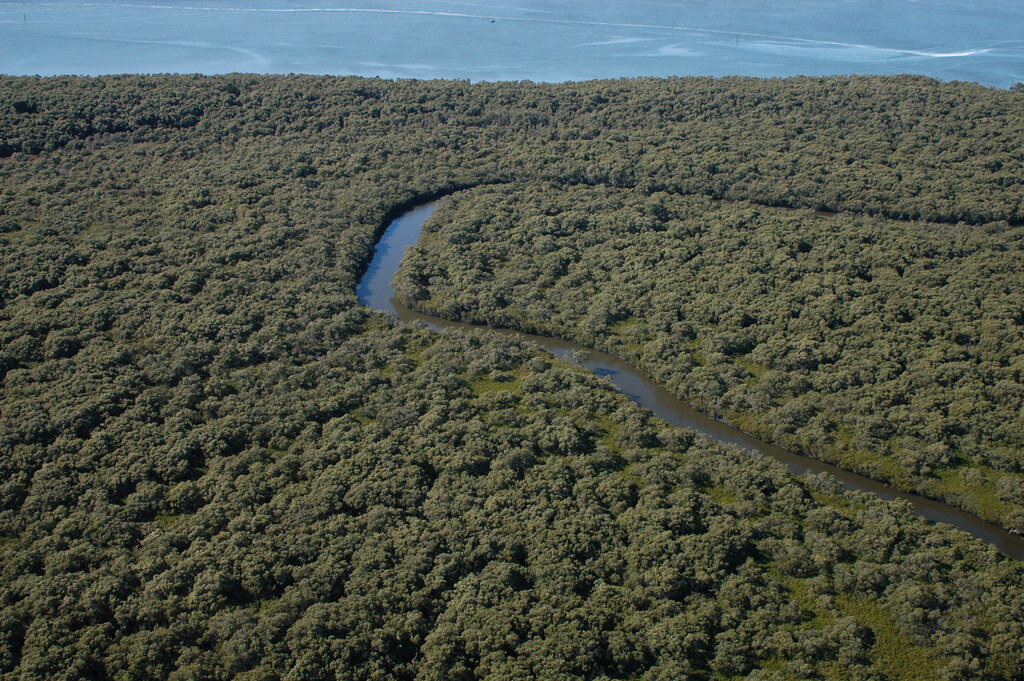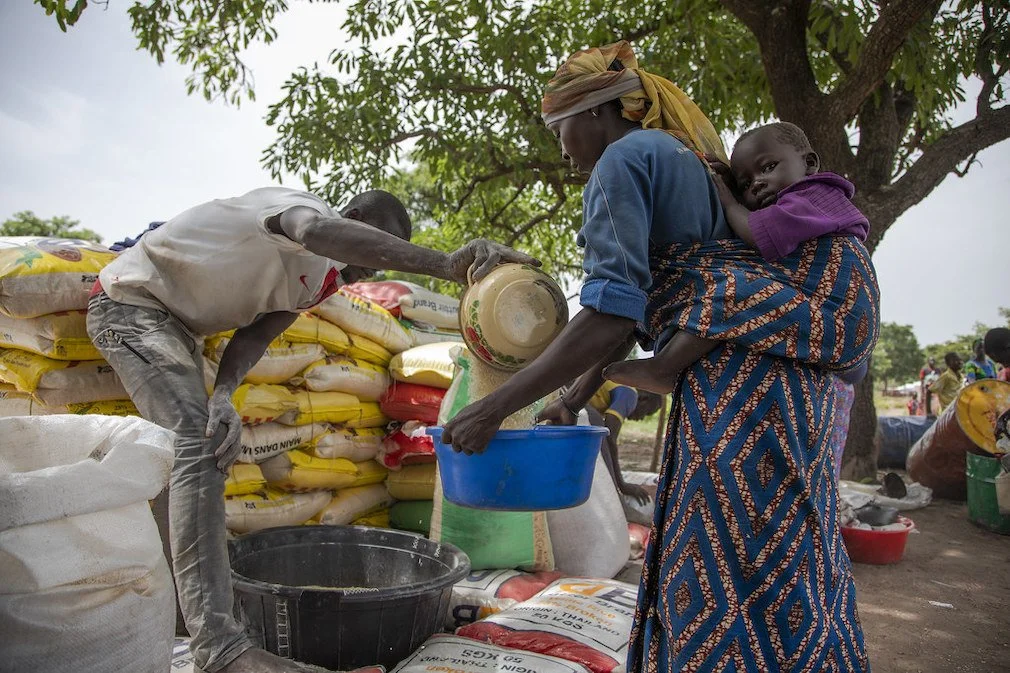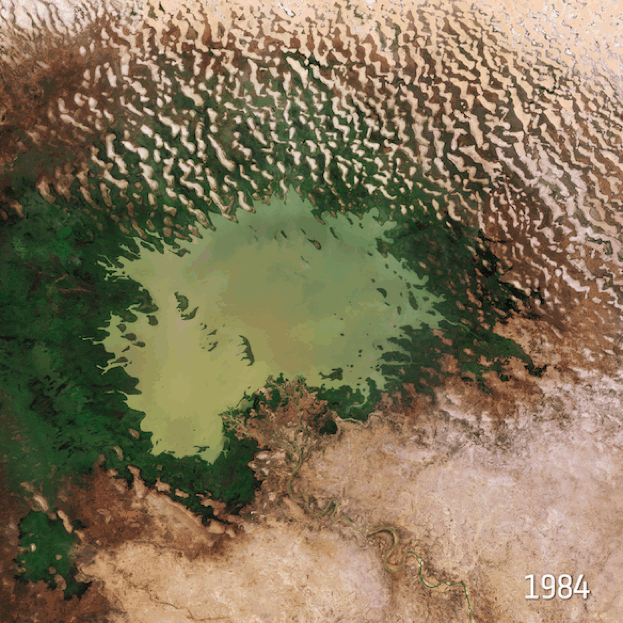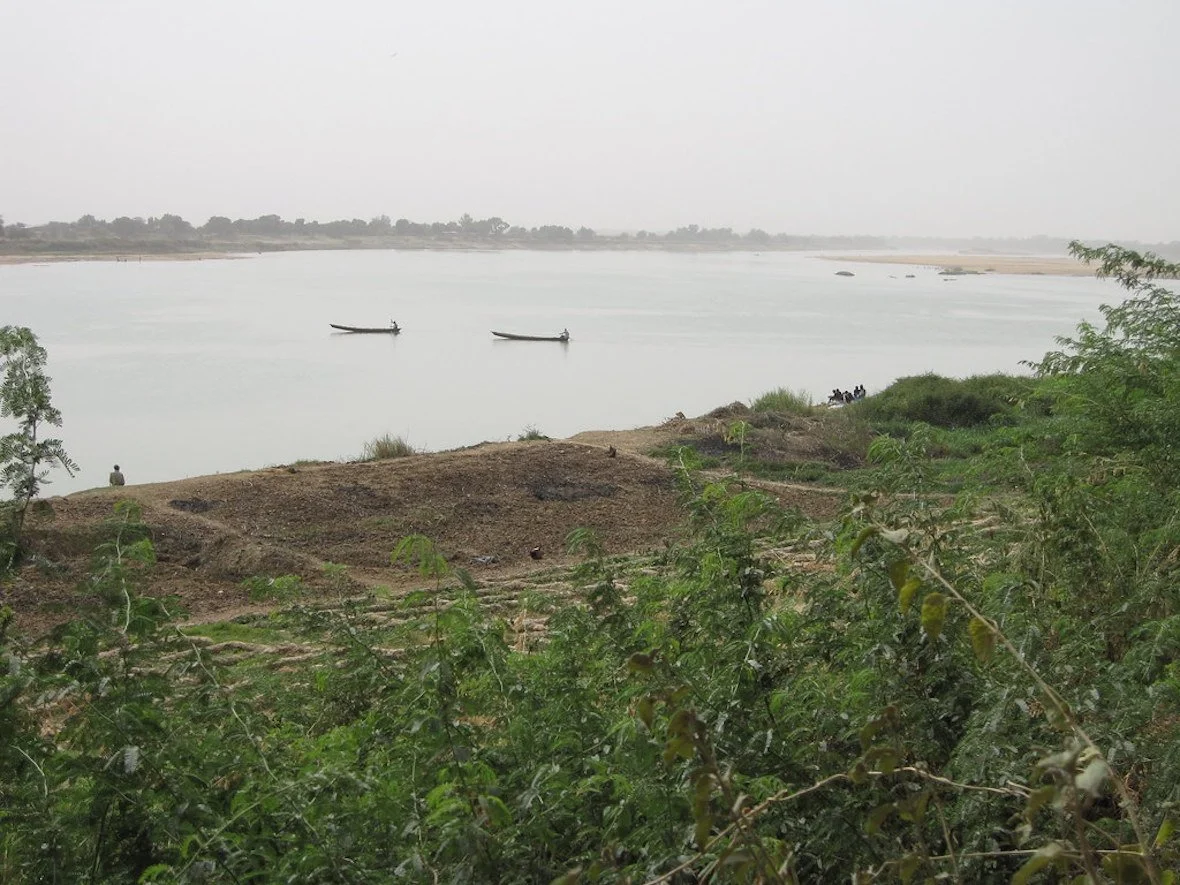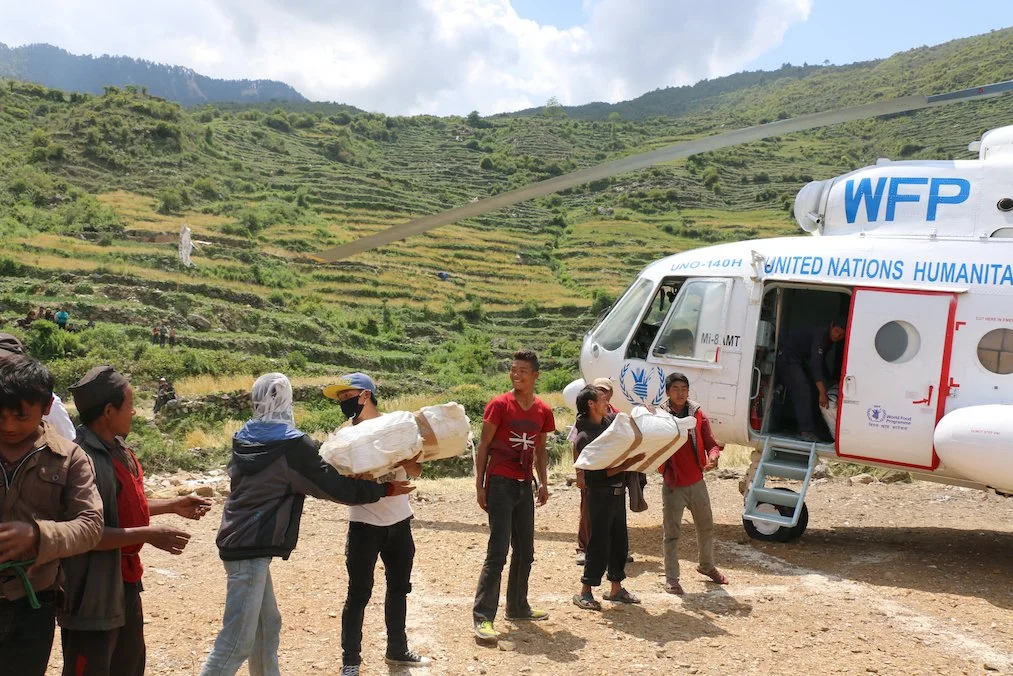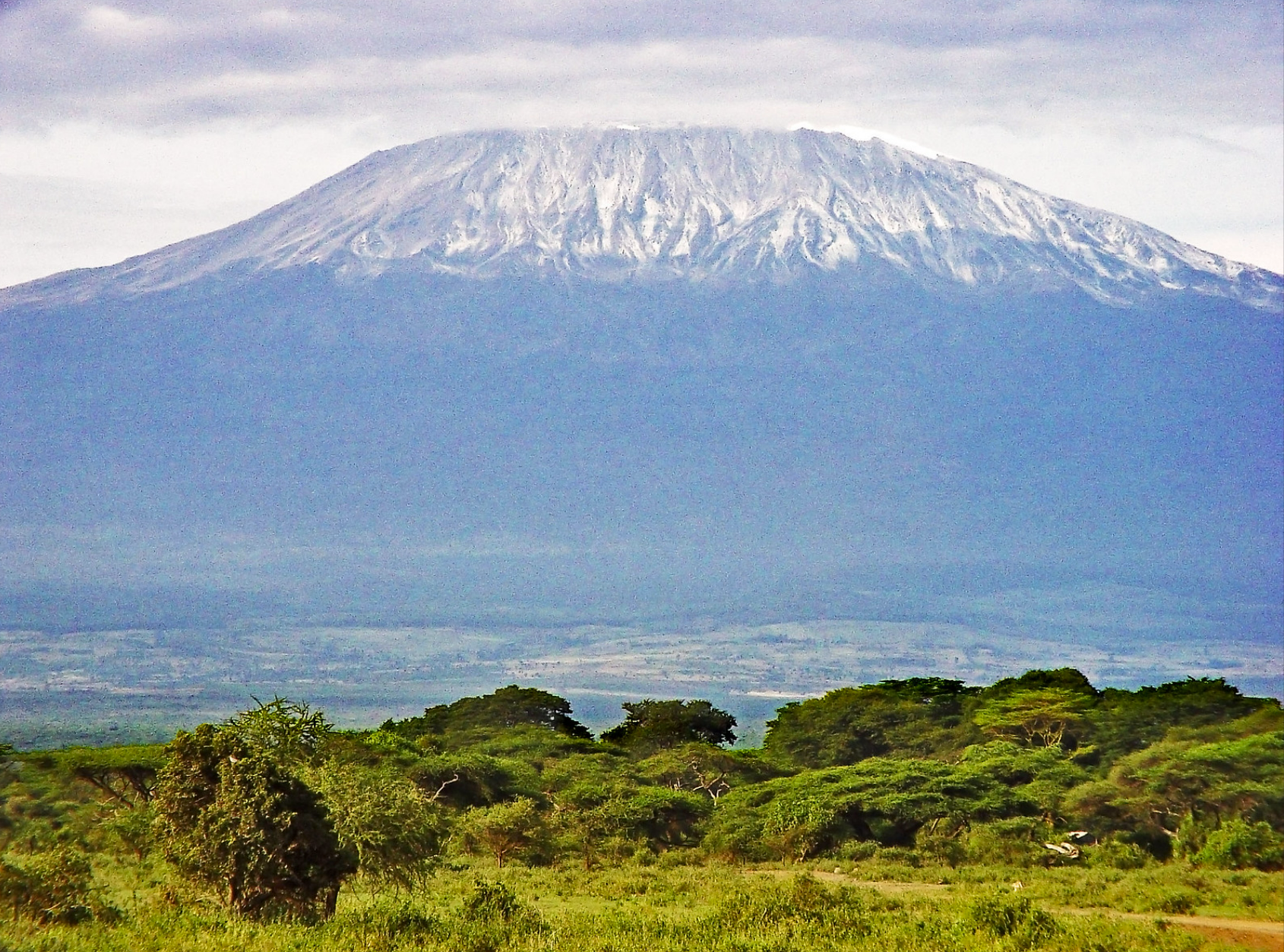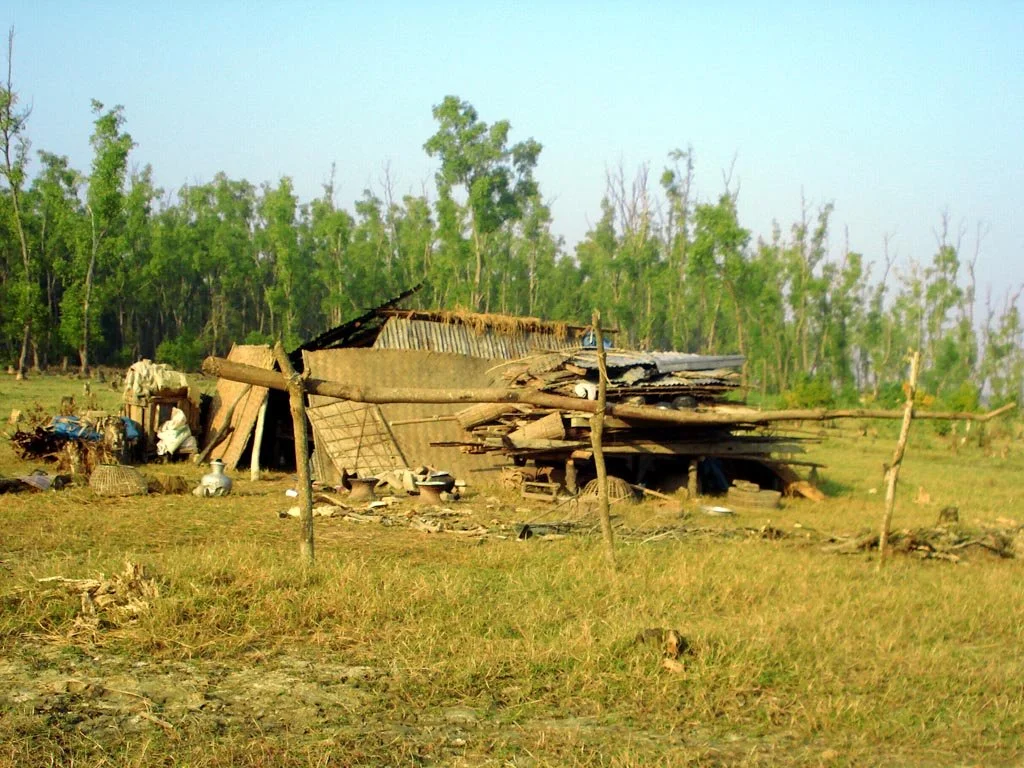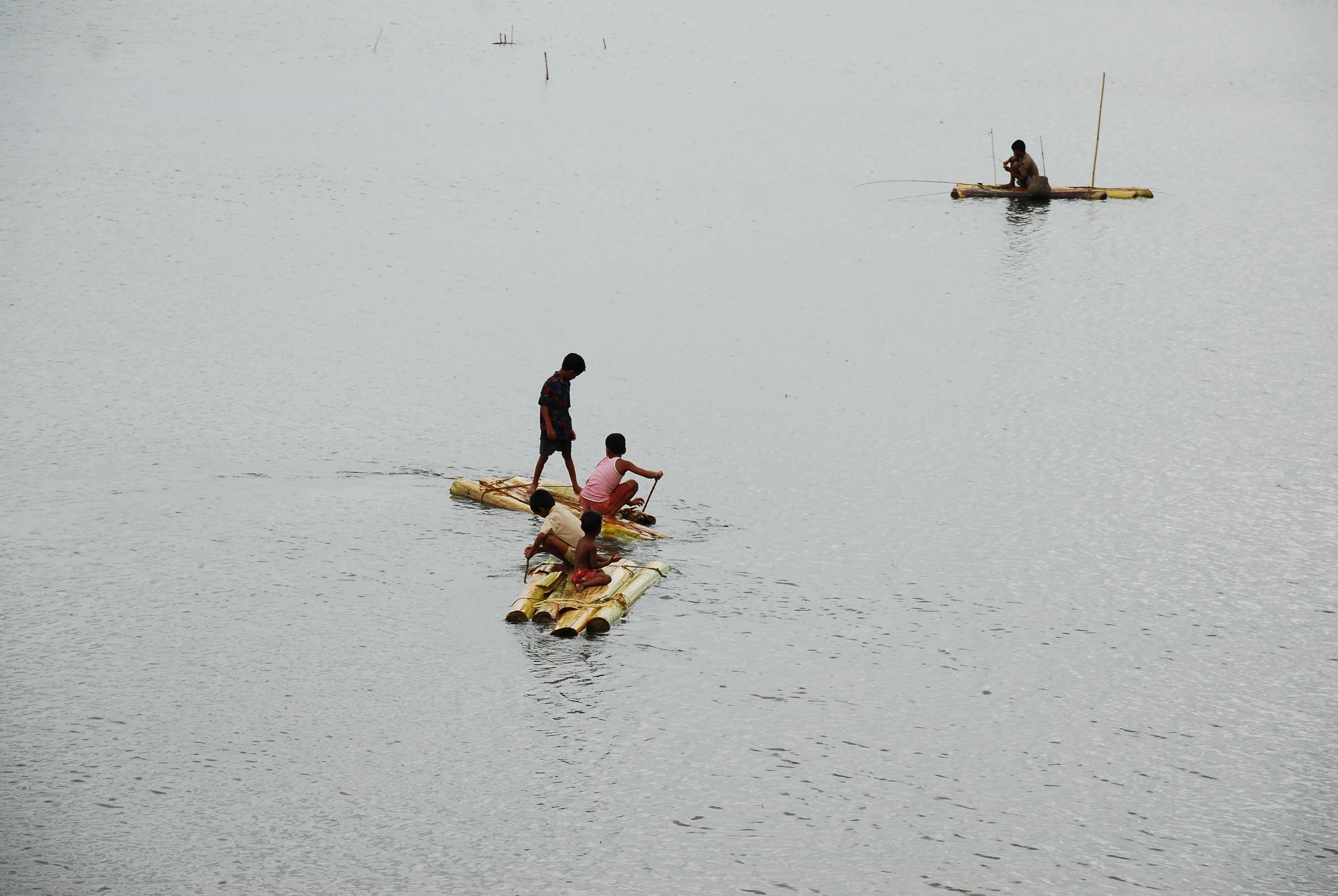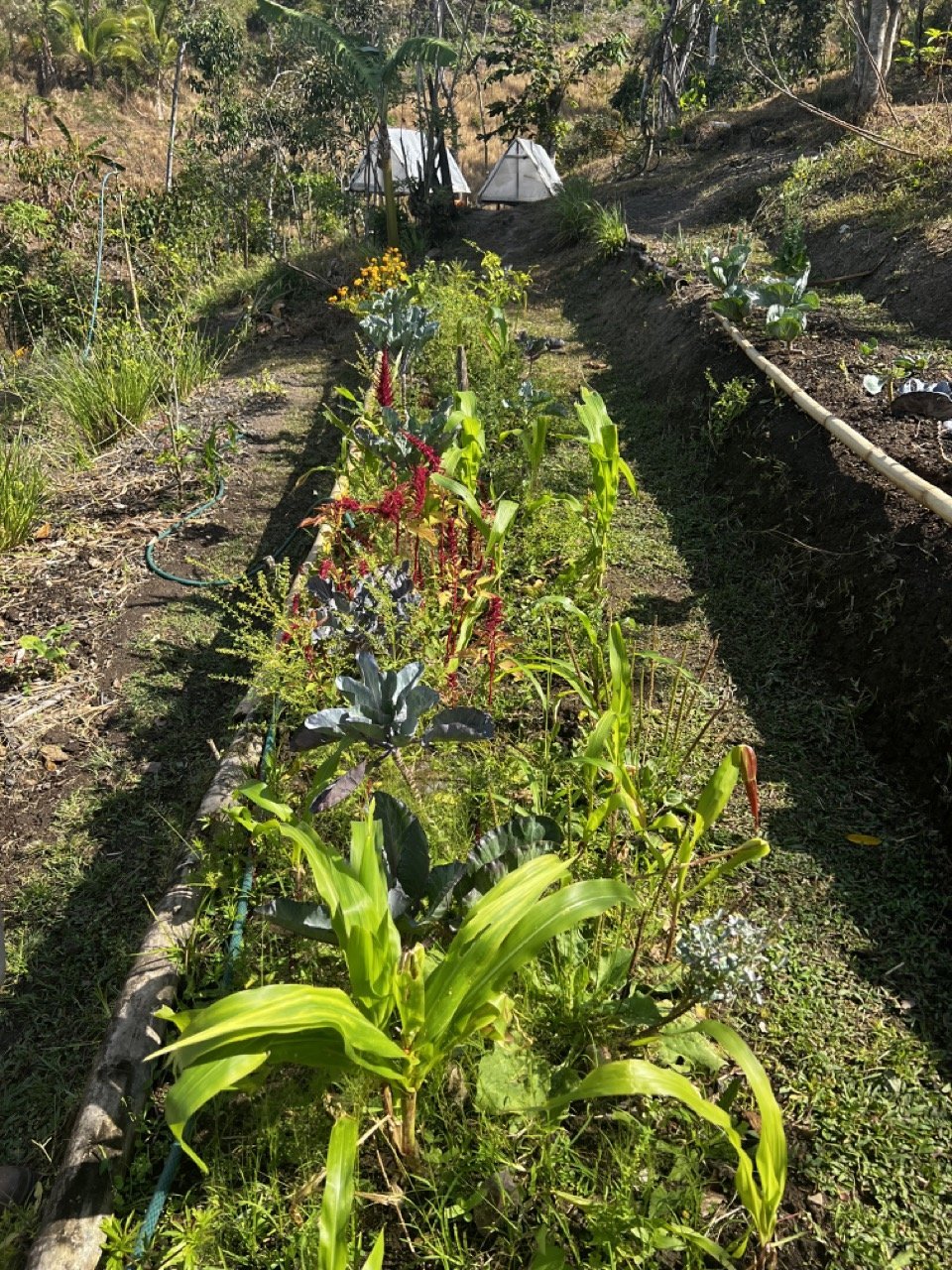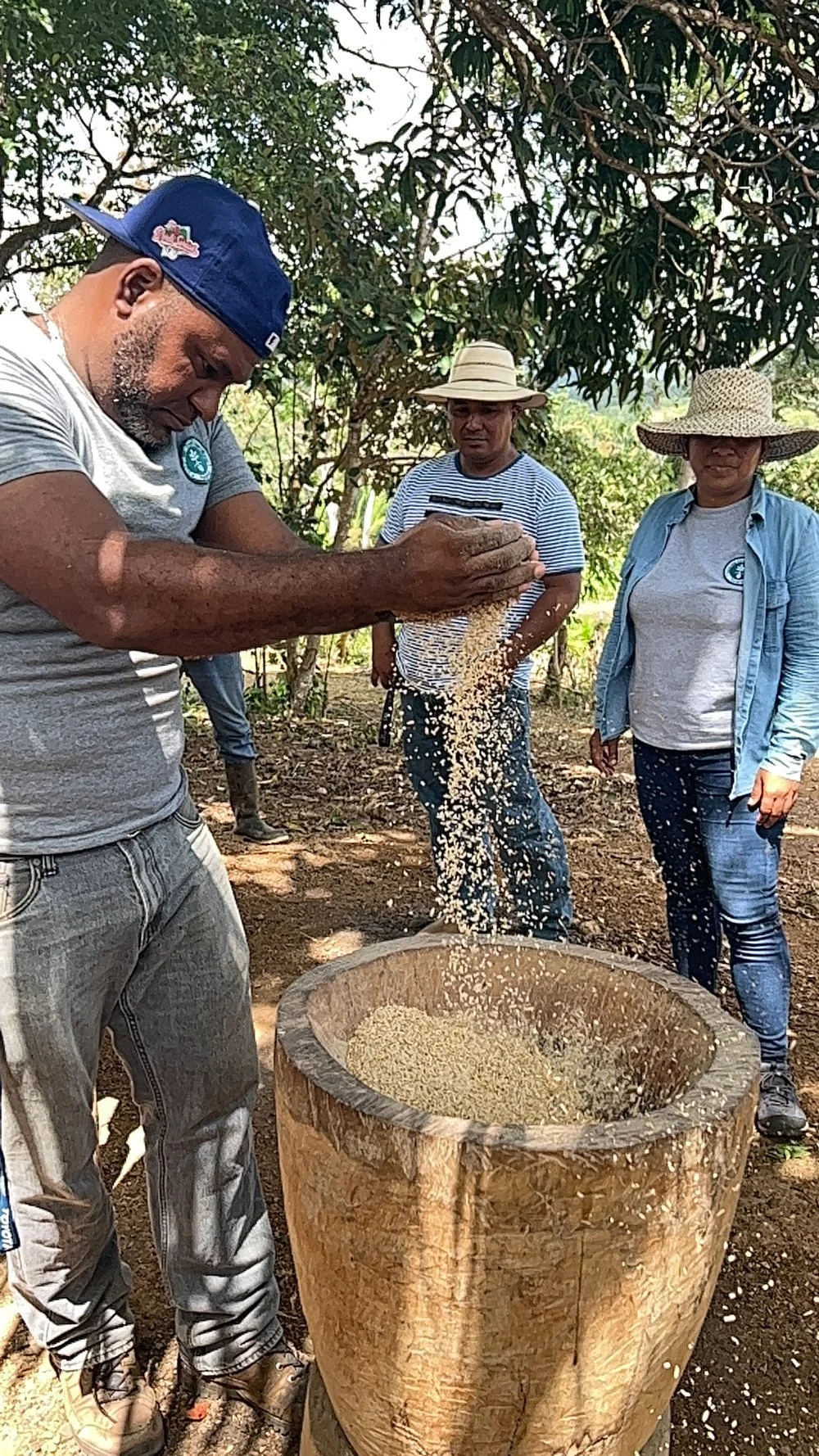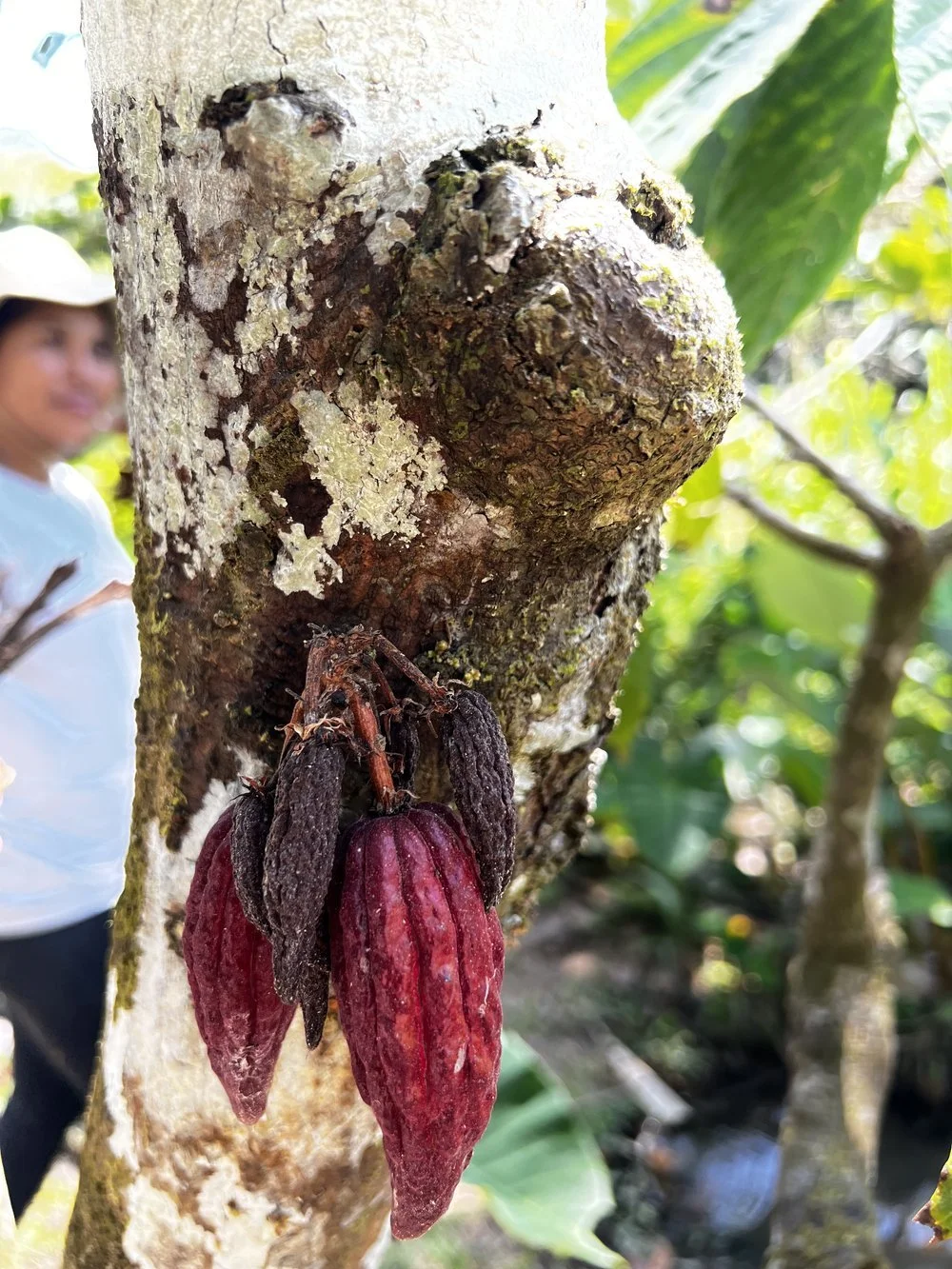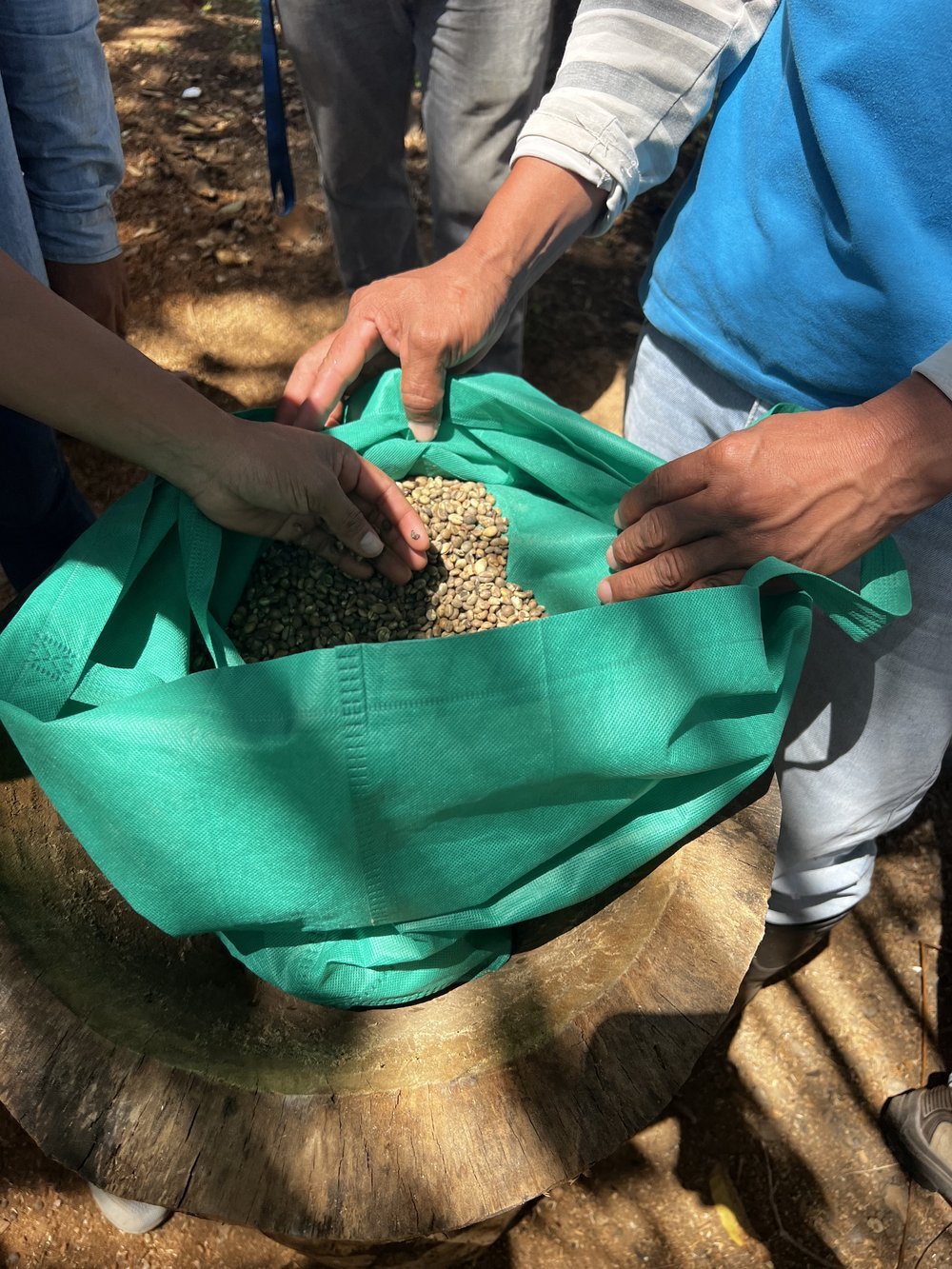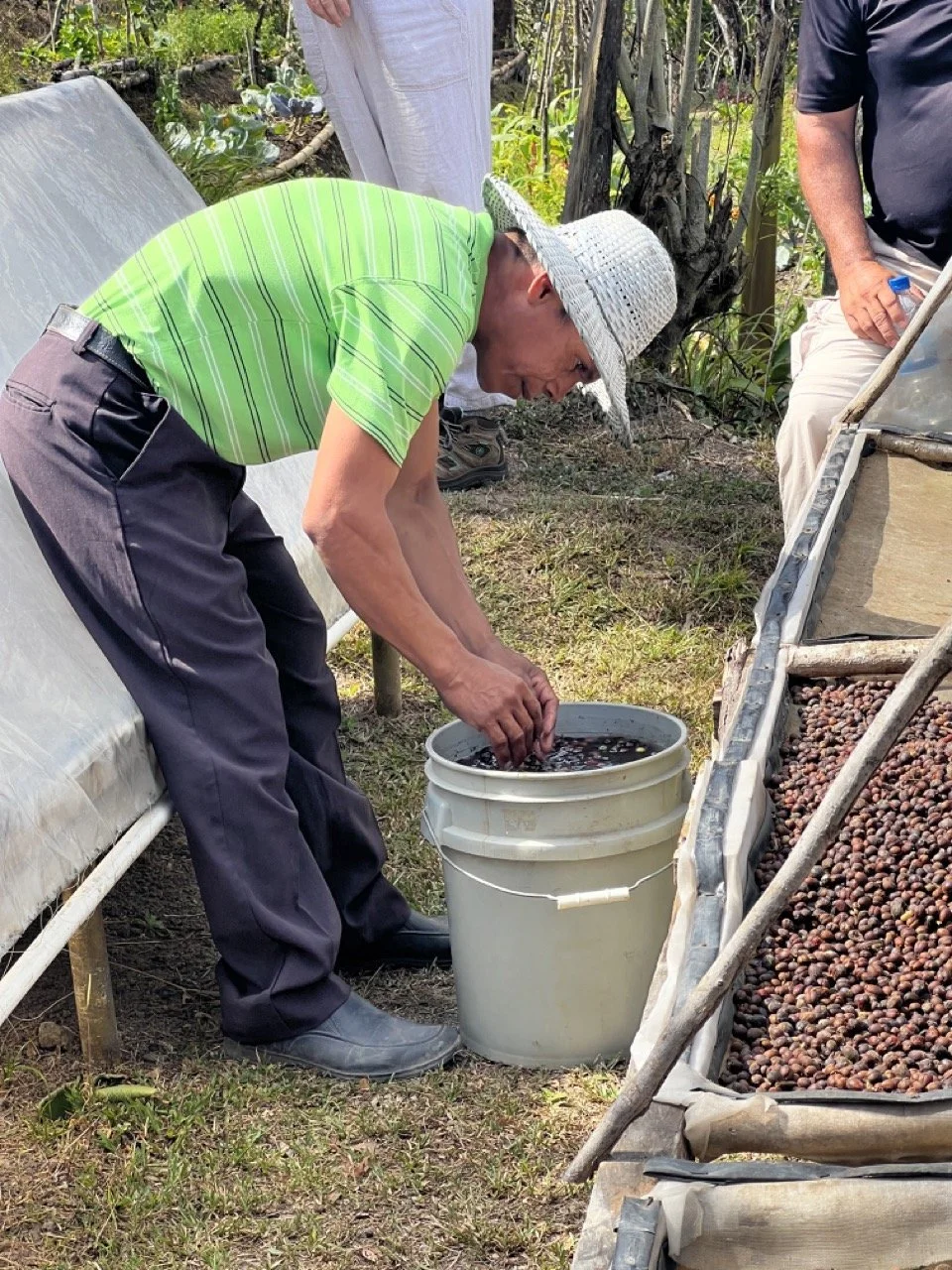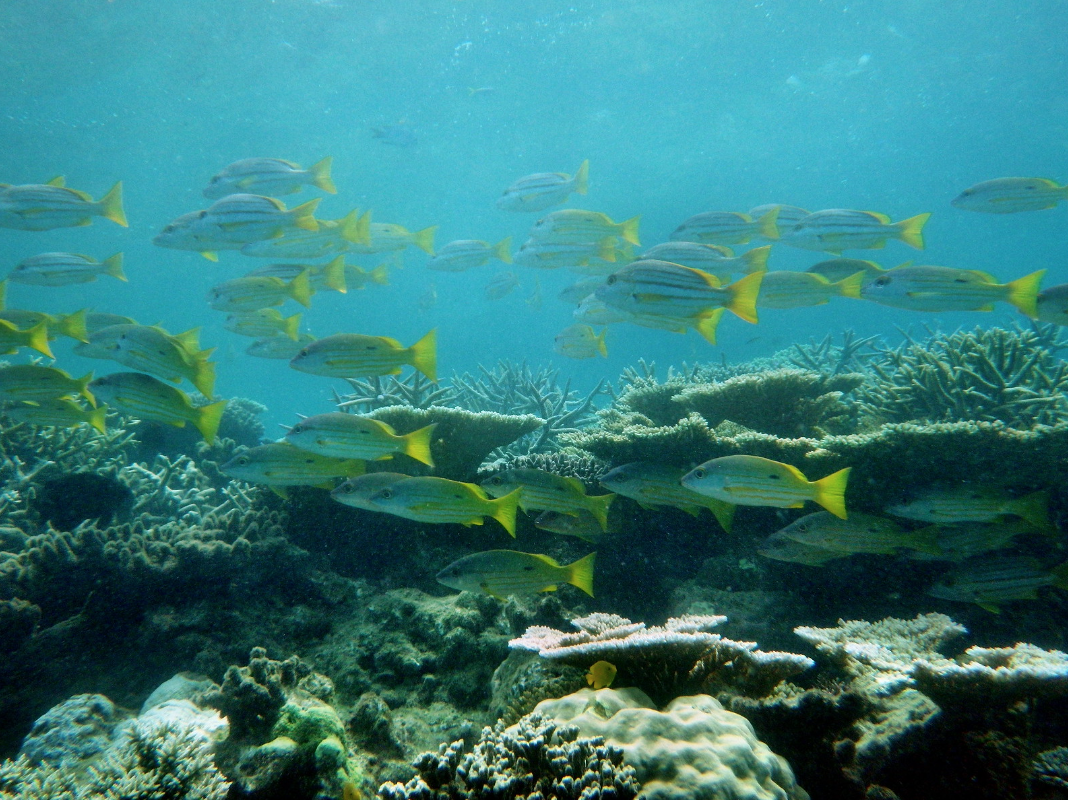Coastal communities worldwide are grappling with the widespread effects of a warming climate and rising sea levels, witnessing the devastation of their homes and increased economic difficulties.
Read MoreHow Countries Are Using AI to Manage Natural Disasters
Countries worldwide are leveraging AI and machine learning to enhance natural disaster management and resilience, with initiatives like the Global Initiative on Resilience to Natural Hazards through AI Solutions leading the way.
Read MoreA Portable Solution to the World’s Water Crisis
Hydro Wind Energy’s Quench Sea device offers a portable solution to the global water crisis, providing communities with access to clean drinking water through innovative desalination technology.
Read MoreSacred Duty: Religious Groups Fighting Fossil Fuels
As the climate crisis continues to worsen, religious climate justice organizations are taking a stand against environmental degradation.
GreenFaith protesting outside of BlackRock in 2022. Felton Davis. CC 2.0.
Over the past few years, the environmental crisis has begun to spiral out of control. As droughts and wildfires compete for attention with raging hurricanes across the United States, sometimes it can feel like the world is ending. But in the face of these natural disasters, people have started to come together, calling for an end to policies aggravating the climate crisis.
Religious teachings surrounding the sanctity and sacredness of Earth have long been folded into protests against the warming climate. Since the 1970s, religious organizations in the United States (primarily Christian and Jewish, although a few Islamic groups have also begun to speak out) have decried humanity’s destruction of the planet. Some, like the National Association of Evangelicals, have gone so far as to denounce those engaging in climate change-fueling activities as sinners.
It is important to note that many religious institutions remain largely disconnected from the climate crisis, with several organizations and churches denouncing it as a hoax. The groups mentioned in this article, and those like them, are largely outliers. Climate change continues to be a divisive topic at best in larger religious dialogues, as many consider the crisis a part of God’s plan or even an outright lie. However, religious climate change advocacy has grown in recent years, with small groups cropping up all over the United States.
Over the past few decades, these groups have grown more and more vocal. From organizing movements to protect the Endangered Species Act to founding an interfaith collective for climate justice, religious leaders and organizations across the United States have continued to take environmental action over the past four decades. Recently, in the summer of 2024, Christian and Jewish protesters in New York City made some of the greatest progress so far.
GreenFaith, an interfaith climate justice organization based in New Jersey, spent much of the summer of 2024 on Wall Street protesting against Citigroup. One of the largest banks in the United States, Citigroup released a statement in 2021 pledging to reach net zero emissions in 2050. However, independent researchers have pointed out that in the years since this pledge, the corporation has instead become the second-biggest investor in fossil fuels.
In response, several organizations joined together in the Summer of Heat demonstrations. Forty major protests were held outside Citigroup’s headquarters, led by a collection of religious leaders from GreenFaith, Dayenu (a Jewish organization comprised of longtime activists), and several other groups. The protests were held according to religious practices — songs replaced chanting, many of the protestors brought candles and demonstrators gathered in the early morning to block the doors of the banks. In an inspiring moment, a group of protestors arrived with signs displaying various religious symbols, representing the star of David, crosses and Islamic peace symbols.
These protests ultimately caught the attention of Citigroup’s administration, culminating in a sit-down between Citigroup’s chief sustainability officer and four leaders of the involved religious groups. According to reports, Citigroup rejected the protester’s proposals outright, refusing to answer whether or not they would change their commitment to funding fossil fuel companies.
However, this rejection does not diminish the Summer of Heat’s influence. These organizations gathered together and staged one of the longest climate protests in recent history. In addition, the actions of GreenFaith, Dayenu and the other involved groups gave a tremendously loud voice to their concerns, capturing the attention of many major news networks and eventually working their way into Citigroup itself. While their efforts may not have produced the results the groups hoped for, the Summer of Heat has nonetheless called an immense amount of attention to the climate crisis and the multicultural, interfaith movements working to protect the planet.
Ryan Livingston
Ryan is a senior at The College of New Jersey, majoring in English and minoring in marketing. Since a young age, Ryan has been passionate about human rights and environmental action and uses his writing to educate wherever he can. He hopes to pursue a career in professional writing and spread his message even further.
Fanning the Flames: Heat Waves Across America Set to Get Worse
An unending barrage of heat waves has pummeled North America in 2024, with climate change the likely culprit.
The sun rises on another 100-degree day in California. Pixabay. CC0
Climate change is an ongoing and severe crisis that is affecting all parts of the globe in different ways. From rising sea levels to increasingly chaotic weather patterns, every part of human society is at risk of some adverse effects.
North America has been suffering droughts on the west coast and frequent hurricanes and tornadoes on the east, but the entire continent is united in facing historically high temperatures. Almost the entire month of July has seen a solid string of heat waves, appearing in every corner of the continent. According to the United States Environmental Protection Agency (EPA), these heat waves have become far more frequent in the last few years, rising from two waves yearly in the 1960s to around six annually in the 2010s. In addition, heat waves have become more intense over the last few decades, with temperatures in Mexico and Central America brushing 125 degrees Fahrenheit in a historic first. Las Vegas also recently witnessed a record-breaking 115 degree day on July 12th, topping off a seven-day streak of broken records.
And these heat waves are only set to continue. As of the time of writing, heat waves are expected to renew their assault on the west coast, with temperatures projected to reach up to 110 degrees Fahrenheit and effect Washington, Nevada, Oregon, Arizona, Idaho and California. In 2023, Las Vegas never dropped from 100 degrees during the entire month of July, while this year’s forecast suggests that the average will have risen to 103 degrees by the end of the month. In addition, July 20th saw parts of Florida setting daily temperature records at around 97 degrees. This is a solid increase across the board for this time of year, with those same parts of Florida sitting at around a mean temperature of 84.9 degrees last year.
The biggest immediate threats presented by the rising temperatures, however, are wildfires. Hot and dry conditions naturally portend fires, and the already dangerous wildfire seasons in California and Canada have only gotten worse as the heat steadily increases. As of July 21st, several wildfires are raging in Oregon and western Canada, and incoming thunderstorms are predicted to make things substantially more difficult for the firefighters struggling to contain the blazes.
Although official statements stop short of absolute certainty, the vast majority of organizations are pinning the blame for these heat waves squarely on climate change. A series of incidents—the rising frequency and intensity of heat waves across the globe over the last few years, reports from 2022 about sidewalks melting in Europe, and 2023's historically devastating Canadian wildfire season—have raised concerns about the damage climate change can do even in the short term. That 2024's heat waves have been worse are suggestive of what is to come.
According to the Canadian Climate Institute, climate change has been proven to raise the frequency of severe heat waves, as well as slowing them down and causing them to linger over certain areas. Additionally, a statement released by the World Weather Attribution suggests that wildfire risk has become significantly higher as a result of climate change, making 2023’s wildfire season in Quebec close to 50% more intense.
It is becoming increasingly clear how rapidly climate change is altering the planet. Heat waves have been increasing in severity for the past few years, with 2023 setting global heat records and 2024 looking to blow even those historic numbers out of the water. These events are becoming increasingly common as time goes on, and it is possible that global average temperatures will rise five degrees by 2050, and around 10 degrees by the end of the century. Even the deviations we’re experiencing now are severe, but it looks like the world is going to get even hotter—and fast.
Ryan Livingston
Ryan is a senior at The College of New Jersey, majoring in English and minoring in marketing. Since a young age, Ryan has been passionate about human rights and environmental action and uses his writing to educate wherever he can. He hopes to pursue a career in professional writing and spread his message even further.
The Cost of Climate Change: Forced Relocation in Panama’s San Blas Islands
Rising sea levels led to the evacuation of about 300 Indigenous Guna families from Gardi Sugdub Island off the coast of Panama on June 1, 2024.
Gardi Sugdub, Panama. Lee Bosher. ATTRIBUTION-NONCOMMERCIAL 2.0 GENERIC
Climate change poses a threat to coastal territories around the world, as warming global temperatures lead to rising sea levels and stronger storms. Gardi Sugdub is one of 365 islands in the San Blas archipelago, many of which are expected to be underwater by 2050. The rising waters along Panama’s Pacific and Caribbean coasts are expected to subject 63 communities to climate displacement throughout the coming decades as about 2% of Panama’s coastal territory becomes submerged. Although the relocation on June 1, 2024, was successful, the 300 Guna families are the first of an estimated 38,000 people in Panama who will require relocation in the short and medium term.
The Guna people, the Indigenous inhabitants of about 50 of the 365 islands in the San Blas archipelago, are the first of these communities to relocate. Indigenous and other marginalized communities are disproportionately affected by climate displacement, where people are forced to move because of climate-related threats or disasters. Inequities resulting from the climate crisis disproportionately harm People of Color, particularly Women of Color. After decades of attempts by Guna community members to receive relocation support, the Panamanian government finally agreed.
The Guna people have inhabited Gardi Sugdub for generations. They arrived on the island about 150 years ago when they crossed the water from the Panamanian and Colombian mainlands. The move off of the island to a landlocked community surrounded by jungle is a challenge for many because over 200 years of Guna culture have been centered around the sea. While most of Gardi Sugdub’s inhabitants relocated, about 200 people chose to stay on the island.
The relocated Guna people have moved to a new community called Isberyala Isberyala, a plot of 300 two bedroom houses situated in the forest, starkly contrasts with life on Gardi Sugdub, where houses were overcrowded and often homed by multiple families. Panama’s Ministry of Housing ensured that the Isberyala residential project includes infrastructure like electricity, playgrounds, cultural spaces and streets named after historic Guna leaders. The people in Isberyala can easily visit their old homes too, as Gardi Sugdub is only a 30-minute walk and a short boat ride away.
TO GET INVOLVED
Those looking to spread awareness and advocate against climate displacement and inequity can learn more and share knowledge with others. People can support mitigation and relief efforts by donating to organizations that support relocations like Swiss NGO Displacement Solutions and the UN Refugee Agency, which recently started a Climate Resilience Fund.
Madison Paulus
Madison is a student at George Washington University studying international affairs, journalism, mass communication, and Arabic. Born and raised in Seattle, Washington, Madison grew up in a creative, open-minded environment. With passions for human rights and social justice, Madison uses her writing skills to educate and advocate. In the future, Madison hopes to pursue a career in science communication or travel journalism.
Climate Change on Trial: Vermont Passes Climate Reparations Bill
After historic flooding, Vermont calls for “Big Oil” to pay its share of the damages.
The Great Vermont Flood of 2023 in Montpelier, Vermont. The National Guard, CC BY-SA 2.0
Climate change has become a serious issue across the globe. Freak weather events, increased global temperatures and glacial melt, among other crises, have made it almost impossible to ignore. And for residents in one state, climate change has come right to their doors for what lawmakers intend to make the last time.
Vermont suffered severe flooding during the summer of 2023—the water completely submerged parking meters in the capital city of Montpelier. Thousands of residents lost cars, homes and businesses. According to the National Weather Service, the damages from this event alone rivaled—and even exceeded—the damage caused by Hurricane Irene back in 2011.
Now, the state government has passed a bill forcing fossil fuel companies to pay for a portion of the damages caused by climate change. Vermont is now the first state in the Union to take these organizations to task for externalities caused by fossil fuel emissions. According to the bill, the Agency of Natural Resources will create a report by 2026 that estimates the cost of climate change-based damage since 1995. This will examine aspects such as public health, agriculture and economic development.
The bill has been lauded for its progressive approach to climate justice, as holding companies accountable for pollution is, perhaps unsurprisingly, very widely supported. However, several Vermont politicians have also expressed concern over what will surely turn into a knock-down, drag-out legal battle come the report’s publication.
This bill marks a huge turning point in the climate justice movement. Although the legal battle has yet to begin, the precedent set by this bill is groundbreaking. The federal government has taken little serious action toward climate change reparations, as they are a divisive issue on a national level. Some consider the process to have very little legal basis, which naturally spawns skepticism that the legislation can actually be enforced.
However, regardless of how the bill has been received, the progress here is undeniable. There’s something to be said for the power of precedent in legal situations. Reparations have been divisive in the court system on account of being largely untested in a legal setting. Most court cases on a federal level are decided largely based on the results of similar cases in the past. Much of the heel-dragging over climate change, then, can be explained by how new and untested many of these legal approaches are.
It’s far more difficult to pass a bill at the federal level than the state, especially when trying to attack such an inflammatory issue. That said, states taking action—successful or not—could begin to wear down that resistance. If Vermont manages to extract reparations from the targeted companies, other states may follow suit. With enough states unified towards climate reparations, the federal government may be forced to take a stance. It likely won’t be for some time, but Vermont’s actions now are potentially paving the way for a massive shift in the governmental response to climate change in future years.
Ryan Livingston
Ryan is a senior at The College of New Jersey, majoring in English and minoring in marketing. Since a young age, Ryan has been passionate about human rights and environmental action and uses his writing to educate wherever he can. He hopes to pursue a career in professional writing and spread his message even further.
Food Fight: European Farmers Battle Food Outsourcing
As climate concerns grow, many feel that the EU’s new agricultural policies are uprooting farmers’ way of life.
Farmers blocking a Berlin road in protest. Leonhard Lenz. CC0
Global warming, climate change, and greenhouse gasses have been hot-button topics for decades, but recent events have painted them in a much more alarming light. Many countries around the world have begun instating policies and procedures to combat this crisis, from carbon taxes to efforts at land preservation and conservation.
But just like every major change, it comes at a cost. Farmers, the backbone of the food market and a group with interests very much built around the environmental status quo, have been upended by recent policy changes. The EU has turned its attention to agriculture in recent months, proposing a variety of policies that will decrease the amount of land being used for farms, dubbed the Green Deal. In addition to stricter regulations, rising operating costs and taxes have also been cited as causes for discontent among the farming population of Europe.
This series of events reached a head in December of 2023, when farmers first began protesting across the continent. At first, it was simple picketing and protests, but in the months since, every possible display of discontent—from holding up traffic to spraying manure and throwing produce—has plagued much of the EU. Farmers in Berlin blocked the road around the Brandenburg Gate with tractors, and others in Brussels lit bales of hay on fire to deter police.
Over the last few weeks, the EU has made several concessions for the aggravated farmers. In addition to relaxing many of the regulations and reducing taxes on the diesel fuel used for tractors and farm equipment, the EU has apparently canceled its plan to import grain and other crops that could be grown in Europe from Ukraine. This in particular drove an especially angry contingent of protests, as the lower price and food standards of imported grain make domestic crops less profitable.
In the months since March, many of the more aggressive demonstrations mentioned above have begun to taper off in response to the EU’s capitulations. This demonstrates a problem that many governments are struggling to face in regards to climate change. The situation gets worse and its effects more severe, but swift action often ends up displacing people who rely on how the system has always been.
Hundreds of millions of people around the world have built their whole lives on the current status quo. Many of the changes that the EU suggested threatened their livelihoods by increasing the competition and undermining their typical methods. Unfortunately, there are not yet systems in place to account for the losses these individuals suffer, meaning future attempts to reduce the impact of climate change will risk the same backlash.
The EU may have been trying to minimize habitat destruction and land overuse, but in the process it risked harming the backbone of its economy and even its food supply. Climate change is an undeniable issue, but one that affects every person in the world differently. Any attempt to fix it will inevitably create some losers, whether the people in charge have accounted for them or not.
Ryan Livingston
Ryan is a senior at The College of New Jersey, majoring in English and minoring in marketing. Since a young age, Ryan has been passionate about human rights and environmental action and uses his writing to educate wherever he can. He hopes to pursue a career in professional writing and spread his message even further.
From Drought to Deluge: Afghanistan’s Flash Floods
As the 6th most vulnerable country to climate change, Afghanistan has faced intensified food insecurity following a disastrous series of floods throughout April and May 2024.
Flood relief efforts in Herat, Afghanistan. NATO Training Mission-Afghanistan. CC BY-SA 2.0
Over the past few months, hundreds in Afghanistan have died due to flooding. In April 2024, at least 70 people died from flash floods throughout Afghanistan. The floods and heavy rains have also destroyed several schools and mosques, in addition to more than 2,000 homes.
Throughout May 2024, over 1,000 houses were destroyed and more than 300 people died from floods in Afghanistan. The hardest-hit provinces include Badakhshan, Baghlan, Ghor and Herat.
On May 10th and 11th floods affected over 60,000 people. The floods destroyed about 500 houses throughout Afghanistan’s Baghlan and Badakhshan provinces with 16 deaths recorded as of May 27th, 2024. Of the 16 deaths, 10 were members of the same family.
The most recent series of floods on May 18th and May 19th, 2024 took the lives of over 100 people and destroyed nearly 1,500 homes. The death toll is expected to rise as search and rescue operations continue.
Because of climate change flooding has increased, and Afghanistan is not the only country facing destructive floods in May 2024. Over the last month, Afghanistan, East Africa and Brazil have been hit with flooding in the wake of torrential rains. Climate change contributes to increased rainfall and flooding because of hotter climates contributing to snow and ice melt and intensified weather fluctuations.
In Afghanistan, the high number of floods and casualties throughout the first half of 2024 followed a dry winter that left the ground unable to adequately absorb the abnormally high rainfall. Afghanistan’s average temperature has increased by about 1.8°C since 1950. Unusually warm temperatures have exacerbated the problem, as snow melts prematurely into the rivers.
Considering flooding is expected to increase throughout the coming months because of the erratic weather spurred by climate change, there is a need for more investments in infrastructure, specifically climate adaptation projects.
Organizations like the UN Development Programme and other UN agencies are dedicated to supporting Afghanistan in risk management, climate resilience and improved resource management.
GET INVOLVED
Emergency assistance is needed by the 38 million people throughout Afghanistan. As the floods have rendered many areas inaccessible by ground transportation, organizations such as the World Food Programme have resorted to using donkeys to transport food and supplies to those in need. To support relief efforts, donations can be made to organizations like the World Food Programme and the UN Refugee Agency.
Madison Paulus
Madison is a student at George Washington University studying international affairs, journalism, mass communication, and Arabic. Born and raised in Seattle, Washington, Madison grew up in a creative, open-minded environment. With passions for human rights and social justice, Madison uses her writing skills to educate and advocate. In the future, Madison hopes to pursue a career in science communication or travel journalism.
10 Places to See Before They Disappear
The casualties of industrialization and climate change.
Read MoreGlitches in Nature: Poland’s Crooked Forest and Moving Sand Dunes
Did you know that there are some fascinating natural wonders in Poland to explore? From bending forests to moving sand dunes, learn more about the nature in this European country.
Read MoreThe Importance of At-Risk Mangrove Forests
Mangrove forests are an invaluable coastal ecosystem. Over the past several decades, they faced massive destruction, and now they are at risk from climate change.
An aerial view of a mangrove forest. Doug Beckers. CC BY-SA 2.0
Mangrove forests are one of the world’s most crucial ecosystems. They provide a habitat to a diverse range of creatures, help protect coastal areas from potentially harmful storm surges and are instrumental in carbon sequestration. For the past several decades, mangrove forests have been steadily destroyed by industrial development and aquaculture, as well as wood harvesting.
Naturally occurring in tropical and warm temperate areas, mangrove forests—sometimes called mangrove swamps—are groups of trees and shrubs that grow along coastlines. There are around 80 species of mangrove trees, all of which are some of the few coastal plants in the world that can prosper in salt water.
Mangrove forests are recognizable by their complex root systems which rise above the water, as though the trees are on stilts. Their raised roots allow mangrove trees to thrive despite the movement of the ocean, as the coastal areas where they grow are flooded at least twice a day with the coming of high tide. The protection provided by tangles of mangrove roots goes both ways, preventing storm surges from damaging inland areas and preventing pollutants from rivers and streams from entering the ocean environment. The above-ground section of the roots helps to slow tidal surges, allowing sediments to settle and build up on the ocean floor, reducing erosion. The entire root system filters out pollutants, like nitrates and phosphates, flowing from streams and rivers into the ocean.
The roots of a mangrove forest. Ravi Sarma. CC BY 2.0
A 2010 study found that mangroves were disappearing globally at a rate of one to two percent a year, and that between 1980 and 2005, 35 percent of all mangroves were lost. About half of the mangrove forests that do remain are reportedly in poor condition. In the past few decades, mangrove destruction was largely due to human activities. Most mangrove forests grow on public lands, very few of which receive any sort of protection. Coastal development such as the construction of hotels, power plants and marinas as well as aquaculture, agriculture, tourism and logging have been the main culprits behind global mangrove loss.
Today, satellite data suggests that human-caused mangrove loss has greatly declined. Thanks to conservation efforts from activists and governments across the globe, mangrove loss rates have decreased by 73 percent since 2000. This is good news, as the loss of mangroves has numerous negative effects on the environment, such as less protection for coastal areas and the loss of biodiversity. Mangroves are home to a variety of species of fish, especially juveniles, which use the mangroves’ root systems as a safe nursery habitat until they mature and migrate to coral reefs and other ecosystems. Mangroves are also the primary habitat for many seabirds and waterfowl, and even some terrestrial animals.
Yet, mangrove forests are still not safe. They face a new pressing threat, which is still rooted in human activities: climate change.
Scientists predict that, as a result of global warming, global sea levels will rise to unprecedented levels by as early as 2050. By the end of the century, sea levels will have risen at least a foot. Mangrove trees will be unable to withstand such rising sea levels; they are unlikely to be able to adapt to new sea levels within the time frame. As sea levels are rising, the chemistry of the ocean is changing as well, becoming more acidic than creatures in mangrove habitats are accustomed to. The creatures are also unlikely to adapt to a new environment quickly enough to survive, meaning that mass biodiversity loss could occur.
The harm to mangrove forests also has broader effects , as mangrove forests are one of the most important ecosystems in the fight against climate change. Mangrove trees are powerhouses of carbon sequestration, capturing carbon and other greenhouse emissions from the atmosphere and storing them in their root systems and soil for thousands of years. As global warming causes sea levels to rise and mangrove forests are lost, this stored carbon will be released back into the atmosphere, creating a positive feedback loop that further worsens the effects of climate change.
Experts agree that saving mangrove forests is key to combating climate change. In 2017, the World Wildlife Fund, Conservation International, The International Union for Conservation of Nature, The Nature Conservancy and Wetlands International partnered to form the Global Mangrove Alliance, which aims to fund monitoring and researching mangrove forests, as well as conservation and restoration initiatives.
To Get Involved:
For more about the Global Mangrove Alliance and how to support its mission, click here.
For information on how to preserve mangrove forests, visit conservation.org.
Rachel Lynch
Rachel is a student at Sarah Lawrence College in Bronxville, NY currently taking a semester off. She plans to study Writing and Child Development. Rachel loves to travel and is inspired by the places she’s been and everywhere she wants to go. She hopes to educate people on social justice issues and the history and culture of travel destinations through her writing.
Flooding in Libya: A Harbinger of Climate Change’s Deadly Effects
Sustainable infrastructure is the world’s best defense against increase in precipitation due to climate change.
Aid workers struggle to reach city in Libya where catastrophic flooding killed thousands. PBS.
Catastrophic flooding in Libya in September has taken as many as 5,300 human lives, according to the Interior Ministry of Libya’s eastern government. Amid such massive human casualties, many around the world are left wondering how such losses may be prevented as climate related natural disasters become increasingly common.
Extreme flooding events like the one in Libya are on the rise as Earth’s average temperature increases, causing more evaporation and thus greater precipitation. According to the EPA, global precipitation has increased by an average of 0.04 inches per decade since 1901. In more than half of recorded locations, flooding is now at least 5 times more common than it was in the 1950s. This month alone, the effects of extreme precipitation and flooding have been felt in Hong Kong, Greece, Turkey, Brazil, Libya and the United States.
In Libya and around the world, urban planning must adapt quickly to the rising threat of flooding. However, this poses a challenge for many developing nations where resources are often either limited or diverted elsewhere. For example, in Derna, the city in northeast Libya that was the most affected by the flooding, neglected infrastructure was in part to blame for the catastrophic loss of human life. Heavy rains caused two dams to burst, dams that experts have been warning are prone to collapse for years. Unfortunately, resources in Libya are generally diverted towards the ongoing civil war. More busy with conflict than governing, public officials failed to provide the necessary repairs on the dams.
Moreover, climate change not only increases precipitation but also hinders the environment’s ability to withstand heavy rainfall. In Derna, the inundation of the area has washed away much of the soil, which would have helped absorb some of the precipitation. The ground in and around Derna has been left hard, cracked, and stripped of vegetation. Due to these conditions, very little water was retained in the ground, worsening the flooding. Globally, similar conditions must be prevented if flooding events like the one in Libya are to be curbed.
Libya is far from the only place where the infrastructure is inadequate in the face of increasingly heavy rains. Most urban areas around the world, even those in rich countries with the resources to adapt like the United States, have not created infrastructure nor correctly supported the local environment to prevent extreme flooding. Globally, urban planning must now be rapidly modified to account for increasing precipitation.
Making the ground more permeable is the most impactful way urban planning can help reduce extreme flooding. One way this can be achieved is through the incorporation of permeable pavement. Using this type technique allows water to pass through porous paved surfaces into groundwater stores instead of overwhelming the local drainage systems. Further, creating more green spaces, including green roofs, trees, parks, and rain gardens, all increase the permeability of the ground. When the ground can absorb more water, flooding events like the one in Libya may be prevented.
Get Involved:
To help Libyan flood victims you can donate to UNICEF, International Rescue Community, or Doctors Without Borders.
Sophia Larson
Sophia Larson is a recent graduate of Barnard College at Columbia University. She previously worked as the Assistant Editor on the 2021 book Young People of the Pandemic. She has also participated as a writer and editor at several student news publications, including “The UMass Daily Collegian” and “Bwog, Columbia Student News.”
Chad is the Country Most Vulnerable to Climate Change
In Chad, climate change creates new challenges for an already disadvantaged population.
Humanitarian aid in Chad. EU Civil Protection and Humanitarian Aid. CC BY-NC-ND 2.0.
Due to its geography, Chad has experienced a temperature increase of 1.5 times higher than other places in the world. With additional disadvantages of poverty and political conflict, Chad has been ranked as the country most vulnerable to climate change. Here are some of the ways Chad is currently being affected by climate change, as well as current action against this crisis and ways you can help.
Lake Chad
Satellite images of Lake Chad’s shrinking waters between 1984 and 2018. Fae. CC BY-SA 3.0 IGO.
With a surface area of 2.3 million square kilometers, Lake Chad is the country’s reservoir. Climate degradation has taken a toll on this freshwater inland sea over the decades, resulting in its shrinkage of 90 percent within the past 60 years. Not only does this affect the country of Chad itself, but also surrounding nations that rely on Lake Chad, such as Nigeria, Niger, and Cameroon. The increasing lack of this water source reduces the availability of drinking water for both humans and animals, and also impacts irrigation and fishing. Access to clean water is an existing issue in Chad, with only 43 percent of the population able to obtain clean drinking water, forcing many to consume unsafe water that exposes them to diseases like cholera.
Flooding
Chari River. Afcone. CC BY-ND 2.0.
In sharp contrast to the drought affecting Lake Chad, the rest of this Sahelian Republic has suffered flood damage over the past year, caused by its heaviest rain season in 30 years. In October of 2022, both the Chari and Logone rivers overflowed, causing 18 out of 23 Chadian provinces to flood. This flooding has affected more than 340,000 people, destroying thousands of homes and farmland. Though climate change has caused much drought in Chad, it is also a contributing factor to this flooding. As climate change causes temperatures to rise, it allows for more evaporation from the ground and water sources, leading to extended periods of drought and punctuated by bursts of extreme rainfall.
Illness
Medicine in Faya-Largeau, Chad. Gerhard Holub. CC BY-SA 4.0.
Another way climate change endangers Chadians is by increasing the probability of illness transmission. As mosquitoes are attracted to water, increased flooding could create a greater risk of malaria contraction. In 2022, there were 1.8 million cases of malaria in Chad, with over 2,500 fatalities. Though malaria cases have decreased over the last 20 years due to an increase in treatment and preventative measures, they have been rising within the last decade, with 190 cases per 1,000 at risk in 2014 versus 206 cases per 1,000 in 2021. An uptick in temperatures can also cause a greater risk of meningitis, an illness that is common in Southern Chad, which is part of a region known as the “Meningitis Belt.” Heatstroke is also a danger to Chadian people, as well as malnutrition, as crops are destroyed by drought and flooding. With only 1 in 17 children having access to soap and water to wash their hands with, there is already a public health crisis in Chad, and rising temperatures only exacerbate the problem.
Resolutions
World Food Programme. Anjeli Mendoza. CC BY-SA 4.0.
Chad National Adaptation Plan Advancement Project (NAP)
Launched in 2018, the NAP was created as part of Chad’s national contribution to the Paris Climate Agreement. With this plan, eight areas are prioritized, including environmental subjects such as agriculture, forests, sanitation, water resources, and more. National planning and budgeting are being developed on these fronts, all aiming to improve conditions for the Chadian population.
United Nations (UN)
In April, the United Nations appealed for $674 million for a humanitarian response plan, in order to address climate, health, and food crises in Chad. The Sustainable Development Group of the UN also aims to aid the country in its struggles by helping the government enact national security, humanitarian and economic policies.
World Food Programme (WFP)
The WFP provides nutritional support to infants, young children, and pregnant women in order to combat malnutrition in Chad, helping 458,000 children and 235,400 nursing and pregnant women in 2021. WFP has also provided meals to schoolchildren and helped restore degraded land.
To Get Involved
Click here to donate to the World Food Programme.
Click here to donate to the International Committee of the Red Cross.
Click here to donate to UNICEF.
Alexandra Copeland
Alexandra Copeland is a student at The College of New Jersey studying psychology and journalism. She is a lover of coffee, dancing, and visiting new places. Being raised with her Greek culture has inspired her interest in cultural customs around the world. She is a passionate writer and hopes that her work will make an impact in the future.
The Disappearing Snows of Mt. Kilimanjaro
As the mountain's snow melts, its ecosystem faces escalating pressures from tourism, climate change, and deforestation.
Mt Kilimanjaro. Tambako the Jagua. CC BY-ND 2.0.
If you have perused Ernest Hemingway’s “The Snows of Kilimanjaro,” you'd be moved by the writer's introspection and memories, and no doubt recall its breathtaking descriptions of Mount Kilimanjaro’s wintery peaks. Nestled in Southeastern Africa, where temperatures often soar to scorching heights, a mountain graced with a frozen crest appears as a natural wonder. Nevertheless, before many have had the opportunity to appreciate its miraculous summit, the pristine snow has begun to melt at an alarming speed.
Rising above the plains of Africa, Kilimanjaro is a dormant volcano and the highest free-standing mountain in the world. Its snow-capped peak is created through a combination of freezing temperatures and precipitation at high altitudes, where the mercury can drop to a frigid 15.98 F, calculated according to the linear relationship between altitude and temperature. Long-term averages indicate that, in the middle of February, snowfall occurs three days per week on Mount Kilimanjaro.
The captivating ice-capped peak of Mount Kilimanjaro renders it a highly coveted destination for tourists visiting Tanzania, with many foreigners and locals flocking to the site each year. As far back as the 1860s, Europeans had launched their quest to summit Kilimanjaro. In 2006, Kilimanjaro National Park Authorities (KINAPA) registered 40,701 climbers on the mountain, with the Machame trail reigning supreme, welcoming 15,879 adventurers. Today, numerous guiding companies, including the African Zoom and Abercrombie & Kent, offer luxury expeditions and comprehensive travel guides for those seeking to conquer the “roof of Africa.”
While Hemingway’s story may have brought Kilimanjaro to the attention of the world, the mountain has long been revered by locals who have given it names like “Mountain of Greatness” in Swahili and “That which defeats the caravan” in Chagga. The Maasai, who have a deep appreciation for Kilimanjaro, affectionately refer to it as the “Mountain of Water” due to its crucial function as the primary source of water for the surrounding area.
Regrettably, as mentioned above, generations to come might be deprived of the privilege of admiring the captivating natural beauty of Mount Kilimanjaro. Several complicated factors contribute to the rapid disappearance of its ice cap. Scientists have established a link between global climate change and variations in greenhouse gasses, along with transformations in land cover. The consequences of climate change loom over developing nations, and Tanzania is no exception. Additionally, glaciers located in tropical regions are more vulnerable to the impact of climate change, and they can only be sustained at exceptionally high altitudes, where the weather is colder than regional averages.
A recent study by the United Nations Educational, Scientific and Cultural Organization (UNESCO) in late 2022 suggests that 1/3 World Heritage glacier sites will disappear by 2050 due to global warming, including Mount Kilimanjaro. Even if global greenhouse gas emissions are reduced, the melting is unlikely to be reversed.
The danger to Kilimanjaro’s ecosystem has not only inspired a widespread climate advocacy campaign but also sparked controversy. In 2002 a group of scientists led by Ohio State’s Lonnie Thompson published a paper predicting that Kilimanjaro would be devoid of ice by 2020. This claim was picked up in 2006 by former Vice President Al Gore in his documentary film “An Inconvenient Truth,” designed to raise awareness about global warming, emphasizing the melting glacier as a potent symbol of the impending environmental catastrophe. A decade later, the World Mountain Forum in Uganda saw the release of a report by the United Nations, revealing that the warming of the Earth’s temperature, caused by climate change, has led to a marked increase in the occurrence of wildfires on Mount Kilimanjaro, which has resulted in a hastened loss of forest cover. The report stressed the gravity of the situation and called upon Tanzania to protect Mount Kilimanjaro’s water catchment area, including reforestation, early warning systems, and climate adaptation strategies.
It’s obvious by now that Thompson et al. and Gore overestimated the future decline of Kilimanjaro’s glaciers. This has led websites such as Climate Realism and The Climate Record, as well as anti-regulation groups, to attempt to use Kilimanjaro’s lingering snow and ice to discredit climate science and Al Gore’s environmentalist stance. H. Sterling Burnett, a senior fellow, and head of environmental programs at the National Center for Policy Analysis criticized the Kilimanjaro snow melting prediction, stating that it is just one of many scare stories that scientists have had to revise or abandon in the face of significant counter-evidence. Although these specific predictions were false, the result of extrapolating past data far into the future, overgeneralization of a complex system, and neglecting the impact of yearly fluctuations in precipitation, this does not mean that Kilimanjaro or the planet at large are safe from the effects of climate change.
Although perhaps relieved by the presence of snow on Kilimanjaro’s ice cap in 2023, residents of nearby settlements confront other severe environmental problems such as dried streams during the sowing season and deforestation, problematic for a country that is heavily reliant on wood products. Additionally, even if the melting of the snow cap is not affected as much as predicted by Thompson and Gore, the vegetation communities’ altitudinal zonation will inevitably change in the medium-to-long term as the climate warms.
Ultimately, it is crucial to prioritize safeguarding the closely-knit ecosystem that surrounds Kilimanjaro’s snow-covered peak by taking necessary steps to bolster its resistance to the escalating pressures from tourism, climate change, and deforestation.
To Get Involved:
If you are looking to explore Kilimanjaro, there are various sustainable approaches to consider. Visit the site of Responsible Travel to learn more.
Mount Kilimanjaro is managed by Tanzania’s Kilimanjaro National Park, which strives to protect wildlife and provide eco-friendly tourism services around the mountain’s local community. Visit the site of Mount Kilimanjaro National Park to learn more.
The African Blackwood Conservation Project (ABCP) focuses on replanting the tree species Dalbergia melanoxylon, also known as grenadilla, African blackwood, or mpingo, in eastern Africa, including the Kilimanjaro area. The ABCP has played a significant role in Mount Kilimanjaro reforestation efforts. Visit the ABCP website to learn more.
Hope Zhu
Hope is a Chinese international student at Wake Forest University in North Carolina studying sociology, statistics, and journalism. She dreams of traveling around the globe as a freelance reporter while touching on a wide range of social issues from education inequality to cultural diversity. Passionate about environmental issues and learning about other cultures, she is eager to explore the globe. In her free time, she enjoys cooking Asian cuisine, reading, and theater.
Bangladesh: Ground Zero for Climate Change
Where the worst affected are among the least culpable.
Bangladesh Ground Zero, SuSanA Secretariat, CC BY 2.0
Despite being home to only 4.21% of the world’s population, the United States is responsible for a full 14% of all carbon emissions. Bangladesh, a densely populated country surrounded on three sides by India, has released a mere 0.21% of the world’s carbon emission, despite making up a substantial 2.14% of the Earth’spopulation. This means that on average, a person in the US releases about 33.67 times the carbon emissions of a person in Bangladesh.
Yet, it is Bangladesh that is facing among the most dire consequences of global warming. Often called “Ground Zero” for climate change, Bangladesh was ranked number 7 in the latest Global Climate Risk Index, and has a higher population than every country ranked above it. With nearly 75% of Bangladesh below sea level, the South Asian country will be drastically impacted as sea levels rise. Consequently, by 2050, the World Bank predicts that Bangladesh will have almost 20 million climate refugees.
Cyclone Aila Climate Change, Mayeenul Islam, CC BY-SA 3.0
These aren’t just empty statistics. A historically large flash flood in May 2022 displaced more than 4.3 million Bangladeshis . For context, the entire population of Los Angeles is 3.84 million people. Moreover, climate change does not just cause huge events like these. Every day, about 2,000 people move from the countryside to Bangladesh’s capital, Dhaka. About 70% of those who move say this is due to either natural disasters or climate change.
Flash floods, amirjina, CC BY-NC-ND 2.0
For those who move to Dhaka life continues to be difficult. Many migrants end up among the 4 million people already confined to Dhaka’s 5,000 poorest neighborhoods, where they will likely suffer from an extreme water shortage. In 1963, when Dhaka had a population of less than a million, the Dhaka Water Supply and Sewage Authority (DWASA) needed to supply only 130 million liters of water a day. Now, with its exploding population of about 23 million, the DWASA must provide 2,590 million liters every day, and dig hundreds of meters deeper to reach groundwater. A similar water shortage is ongoing in Bangladesh’s second biggest city, Chittagong.
Korail, Dhaka / BD, 2014, william veerbeek, CC BY-NC-SA 2.0
Bangladesh does not have the resources to survive this crisis on its own. The World Bank estimates that Bangladesh needs about $5.7 billion per year to fund climate adaptation programs by 2050. Today, the country is spending about one billion dollars annually, approximately six to seven percent of its GDP, on climate adaptation. Of that money, only 25% is from international development partners. In 2009, at the 15th UN conference of parties, the world’s developed nations committed to spend 100 billion USD per year on climate action in developing countries by 2020. In 2019 however, only $20 billion of global climate finance funds went to climate adaptation.
TO GET INVOLVED
The Bangladesh Rural Advancement Committee (BRAC) is the largest Non-Governmental Organization in the World. They work in 11 countries in the global south to counter climate change, eliminate extreme poverty, and support locally led climate adaptation. According to the Executive Director of the BRAC, the largest Non-Governmental Organization (NGO) in the world, it would cost them only $350 to provide safe drinking water to a Bangladeshi household for 20 years, $8,000 dollars to build a climate resilient house, and $126,000 to create a climate adaptation clinic that can support 3,500 farmers. If you would like to support BRAC, you can donate to them here.
The Bangladesh Environment and Development Society (BEDS) works to balance humans and nature, mitigating the harmful effects of climate change. Recently, they have focused on supporting citizens on the sundarban coast by supporting nature based solutions such as mangrove based livelihoods and integrated farming. You can support BEDS here.
In 1992, Friends of the Earth International founded the Bangladesh Environmental Lawyers association (BELA). Beginning as a local young advocacy group, BELA uses the law to protect the environment, and the people that live within it. While there is no way to donate to BELA specifically, you can support Friends of the Earth International as a whole here.
Jeremy Giles
Jeremy is a Writing Seminars and International Studies major at Johns Hopkins University. He is an avid writer and the Co-Founder of Writers’ Warehouse, Johns Hopkins’ first creative writing group. He is an advocate for Indigenous rights, and studies how Indigenous philosophies can be used to help prevent climate change. Using his writing, he hopes to bring attention to underrepresented voices in today’s world.
Reversing Climate Change One Smallholder Farm at a Time
If the world's smallholder farms used sustainable and regenerative agricultural practices, they could bring us 53% of the way to meeting the United Nations’ net-zero carbon goals.
A hillside slashed and burned, degrading the soil, destroying wildlife habitats and releasing carbon stores into the atmosphere. Adam Cohn CC 1.0
This past February, I worked alongside Sustainable Harvest International (SHI) and their field trainers in Penonome, Panama. SHI is a non-profit organization that opened its doors in 1997 and operates predominantly in Central America, addressing slash-and-burn agriculture, rural poverty, and their connection to climate change.
The Link Between Slash and Burn Agriculture and Rural Poverty
Slash-and-burn agriculture is practiced by 500 million farmers globally. In fact, 20%-30% of deforestation is estimated to be caused by it, directly resulting from a lack of educational opportunities and resources. Similarly, 3.1 billion people worldwide live in poverty, many starving on land ready and available to be farmed. Looking at these issues as one, we’re faced with poverty in rural places and environmental degradation being unavoidably and intrinsically linked.
A smallholder farmer raises fish and livestock or cultivates crops in a limited capacity. In the developing world, a smallholder farm is typically family-owned, and most cultivate less than 5 acres of land. If all 6 million smallholder farmers had the knowledge and training to implement regenerative and sustainable techniques, they wouldn’t have to worry where their next meal was coming from or if their land was healthy enough to be passed from generation to generation. Farmers would no longer have to walk miles to find ground healthy enough to plant for a single season, forced to move further to the following plot the following season. They would have enough food to sustain their families and communities during, for example, a global pandemic—and sell their organic produce at the market for a living wage. Their food would double as medicines, healing bodies from the inside out and healing the soil at once.
What if being able to farm this way simultaneously drew 6 billion tons of carbon from the atmosphere into nutrient-rich soil—the equivalent of shutting down every coal mine? Then, imagine it only costs ~$5,000 for a smallholder farmer to experience and create this transformation.
Many farmers are left with some of the most difficult to cultivate land. They take advantage of the mountainous terrain with terracing. Raeann Mason
Even in the dry offseason, a skilled farmer tends to crops growing on a lush, terraced hillside. Raeann Mason.
Sustainable Harvest International
This is where Sustainable Harvest International comes in. It began as Florence Reed’s dream to mobilize her knowledge, and the knowledge of others, to heal our planet and its people and reverse the effects of climate change through agriculture. As of today, more than 3,200 farmers have been through the SHI program, planting over 4M trees, regenerating over 26K acres of previously degraded land, and building more than 2K clean wood-conserving stoves. And they’re only just getting started. SHI is working tirelessly to scale its programming; by 2030, its goals are to
transform 1 million farms
plant 1 billion trees
sequester 18 million tons of CO2
regenerate 8 million acres of land
achieve food security for 5 million people
I learned quickly that SHI isn’t interested in promises of “going net zero” or slowing the rate at which the atmosphere is warming through offsets. Instead, they work directly with smallholder farmers to prevent more destruction and undo the damage already done in their lives, their land, and the planet’s climate; their work goes beyond sustainability— it’s regenerative.
Sustainable Harvest International’s Field Trainers demonstrate how to use the wind to separate rice husks. Raeann Mason.
A farmer explains how his terraces are braced with grass to prevent runoff. Raeann Mason
How It Works
With Sustainable Harvest International (SHI), farmers commit to learning new methods and receive hands-on tactical training and education. Each program phase lasts around one year, taking 4-5 years and ~$5,000 to complete. SHl hires local field trainers with sustainable and regenerative agroforestry training, local history and insight, and agricultural experience.
A farmer shares the pictures she drew of her farm in the present day compared to what she hopes her farm will look like by the end of the program. Image courtesy of Sustainable Harvest International.
The Phases
During phase one, farmers and field trainers dream together, planning and plotting how much of their land they’re willing to commit to learning new techniques, discussing long-term goals and drawing a picture of what they hope their degraded land will look like by the end of the program. I was so moved by the hope these colored-pencil drawings provide, and when the program is over, they stand as a testament to the process—how much work it took and how effective it was.
Phase two is about learning new practices, focusing on health and nutrition for the body and the soil. Many of the people I met were subsistence farmers, which means they were growing food to meet their immediate needs to survive; no working farm=no food. When we talk about making changes in our life for the sake of our planet—riding a bike to work, ditching single-use plastics—most of us aren’t faced with the fear that if it doesn’t work out, our ability to survive, for our families to survive, is at risk. This is why when I say these smallholder farmers are the closest people I’ve met to real-life superheroes, I’m not exaggerating. They’re willing to put it all on the line to make a change, not just for themselves but for you and me. Despite years of slash-and-burn tradition and generations of methods passed down, they’re choosing to take the risk on something unknown. They’re choosing to heal our planet. Witnessing this posture of vulnerability, I was forced to grapple with the level of my own (un)willingness to sacrifice and risk-take for the sake of humanity and our shared planet.
A farmer cuts the stalk of a plantain tree for composting. Raeann Mason
Farmers in Panama learn to make “ensalada de vegetales,” in English, “vegetable salad,” which is nutrient-dense compost. Raeann Mason.
I was also struck by SHI’s commitment to maintaining and supporting farmer autonomy, allowing them to choose the type of crops to grow throughout the program. All the farms I visited had a different layout, each an oasis of its own right, with different visions and hopes to meet the families’ needs. Farmers are trained to understand the adverse effects monocropping has on biodiversity and are eager to grow crops ranging from cacao trees, pigeon pea shrubs, herbs and spices, peppers, cucumbers, rice, coffee, yucca, yams, plantains and so much more. One farm, in particular, was set in the trees, a forest of life-giving foods hidden in plain sight, masked by the assumption that farms don’t look like rainforests.
Chocolate growing, hidden in plain sight. Raeann Mason
Coffee harvest. Raeann Mason
Phase three shifts gears from subsistence farming and scales to commercial education and training, which centers on environmental stewardship. Here again, I saw how SHI goes above and beyond the work of typical non-profits. Farmers find themselves with an abundance to sell, and the focus on land restoration and conservation begins to turn the heads of neighboring farmers. The farm starts to take care of itself, money earned allows farmers to thrive, and regenerative practices keep the soil nutrient dense for every growing season. Many farmers will choose a select few crops to grow commercially beyond what they grow for themselves. I saw lots of coffee being produced for this, but instead of a flat field of endless rows of coffee under manufactured shade, the crop was planted alongside plantain trees and corn, scattered about the farms and tucked within treelines; everything felt native.
Phase four is all about business development and micro-finance. The farms I worked on in phase four allowed me to listen and learn in the place of laborious volunteer work. Farmers have been relishing the benefits of adopting regenerative practices during this phase. Their history with the land, the tactical support and guidance of SHI’s field trainers, and the confidence from seeing the literal fruit of their labor meant as a volunteer, there was little I could bring to the table aside from profound respect. There’s an indescribable excitement on farms in this phase, or perhaps it’s being able to sense the weight of living in survival mode lifted.
An SHI stove featured in a farmer’s kitchen set up next to the typical stove, which is the pile of rocks in the lower right corner. Raeann Mason
Demetrio dries coffee beans in the sun. Raeann Mason
In phase five, farmers reach that inevitable state of being a community leader and graduate from the program. Graduation is more of a celebration than a formal affair because by now, the farmers and SHI field trainers are like family—bonding through fear, hope, sweat, body aches and success, freedom and trust hard earned. Some farmers go on to work for SHI as field trainers, and others are hired as consultants within their own communities because their farms can be sustained with much greater ease, while others become the experts in their communities which neighbors look to for advice.
Volunteers take a break from leveling a rice paddy. Kate Herndon.
While most of my time with SHI was spent getting my hands dirty on projects like terracing and planting rice paddies, there was one farm I visited that graduated from the program a decade ago. It was time to size SHI up against the truest test: time. Too often, I see organizations with good intentions come in like a storm, ask people to radically change their methods, and dash once the program is over. But a decade later, Demetrio, the field trainers, and even the founder of SHI, Florence Reed, greeted each other as old friends on a farm resembling a lush oasis or eco-wildlife resort. Demetrio has become so successful with his farm that he’s now hired as a consultant in surrounding communities. He’s a true testament to the effectiveness of the SHI program—friends, community members, and SHI field trainers consider him a bit of a legend because he has been able to grow strawberries on his farm in the mountains of Penonome—something considered impossible for that region. He also attested that during the last government-led health audit, his family walked away with a clean bill of health while neighboring farmers practicing monocropping and slash-and-burn techniques were hit with an onslaught of diagnoses and medications to manage due to a lack of nutrition; an issue SHI trained farmers don’t have to face to the same degree.
Farmers are trained to take advantage of their hilly plots of land by growing tilapia-fertilized and terraced rice paddies. Raeann Mason.
In fact, SHI offers more than tactical agricultural training. Aside from their commitments to climate action and ending and preventing poverty and hunger, SHI is committed to clean water access and sanitation. Many homes utilize unsafe, life-threatening cooking stoves. SHI has worked to increase the life expectancy of women by implementing a safer cooking stove that ultimately requires fewer resources. They also build composting latrines that provide cleaner, eco-friendly, and agriculturally beneficial alternatives to burying human waste. One farm learned to harvest clean, fresh spring water from the mountain top. Another family shared that what they learned about microfinance allowed them to spearhead a community funding program, training other farmers to manage their commercial endeavors and providing grants to help them get started.
An inevitable ripple effect is occurring in Central America, one that you can only understand by listening and learning. It’s always a humbling experience when someone signs up to volunteer, gets their hands dirty, does back-breaking work, and then has the luxury to leave that work behind. But in a more nuanced way, I understand it’s not volunteer work that is planting the seeds of healing, that it’s these smallholder farmers who are genuinely risking it all, making the lifestyle changes and healing the planet by their own hands. So what can we do to support them?
To Get Involved:
There are several ways to support the efforts of SHI. You can start by sharing this article in your network to help spread awareness. Most importantly, there are several ways to donate, including signing up for their Legacy or Sustainer giving programs. You can even see the impact of your donation and travel to a program site in Central America. They offer career opportunities and internships; you could join their mailing list here. Remember, it only costs $1,000 per year, for only 4-5 years, to completely transform a farmer's life and improve the health of our planet.
Raeann Mason
Raeann is the Content and Community Manager at CATALYST, an avid traveler, digital storyteller and guide writer. She studied Mass Communication & Media at the Walter Cronkite School of Journalism where she found her passion for a/effective journalism and cultural exchange. An advocate of international solidarity and people's liberation, Raeann works to reshape the culture of travel and hospitality to be ethically sound and sustainable.
The Great Barrier Reef is Disappearing—Here’s Why That’s Important
With the pressing issues of climate change, The Great Barrier Reef is at risk of vanishing completely, but there are still ways to help.
Great Barrier Reef, Australia. @eutrophication&hypoxia. CC BY 2.0
Sprawling at a breathtaking 344,400 square kilometers off the Queensland coast in Australia is the world-famous Great Barrier Reef—known to be the largest coral reef system on the planet and home to thousands of different marine species. It’s a widely-visited tourist attraction and is often named one of the seven natural wonders of the world for its sparkling azure water and decorated rainbow of corals.
But with the recent climate crisis, things are changing, and the Reef is now at great risk. Within the past 30 years, it has lost half its coral cover and global warming has produced a horrific case of coral bleaching—a process where the water warms and corals expel the algae living in their tissues, turning the coral completely white. Without this algae, the coral isn’t able to get the nutrients it needs and will starve to death if water temperatures don’t return to normal.
Why are coral reefs so important to the world? First of all, the biodiversity living in these waters isn’t found anywhere else. It takes up just 1% of the ocean floor but 25% of all marine life calls the Great Barrier Reef their home. It also provides Australia with billions of dollars in economic value with the tourists it attracts. Not to mention, reefs are a great resource to use for medical treatments. Right now, the plants and animals found within are being used to develop potential cures for diseases like cancer and Alzheimer’s.
The Reef is home to countless marine species. Paul Toogood. www.Castaways.com.au. CC BY 2.0
We’re at a critical tipping point. If damage to the reef progresses as it is now, the Great Barrier Reef could be completely gone by 2050. With half a billion people depending on reefs for food and work, this would have staggering effects, and all of this relies on preventing climate change.
As discussed in the COP26 United Nations conference in 2021—the UN Climate Change Conference that brought together 120 world leaders—the Australian government and the entire world must work to limit warming to no more than 1.5 degrees Celsius, in order to keep coral reefs alive. At the current rate, temperatures are increasing at 2.4 degrees Celsius, and 99% of all coral reefs may be gone in the near future.
TO GET INVOLVED
However, the reef is not beyond saving. Visiting the tourist attraction may actually benefit the ecosystem since all visitors are required to pay an Environmental Management Charge, which goes toward the conservation of the reef. Learn more about the nonprofit organizations that raise money to conserve coral diversity, such as GBR Legacy, and maybe even consider donating.
The numerous and easiest ways to help save the Great Barrier Reef come from afar, starting with the changes that people can make in their everyday lives. With climate change comes rising temperatures on the land and in the oceans, which leads to increased carbon dioxide along with ocean acidification and coral bleaching. To remedy this, reducing plastic usage like bringing a reusable cup or installing solar panels to power our homes are both eco-friendly and may save money in the long run.
Michelle Tian
Michelle is a senior at Boston University, majoring in journalism and minoring in philosophy. Her parents are first-generation immigrants from China, so her love for different cultures and traveling came naturally at a young age. After graduation, she hopes to continue sharing important messages through her work
15 International Activists Under Age 30 Changing the World
This new generation is fighting for a fairer world — from poverty to the climate crisis, from Argentina to Pakistan; these activists are all under 30 and making their voices heard.
Read MoreThe Environmental Benefits of Veganism
Beyond clear health benefits, being a vegan may mitigate global warming.
An eco-friendly produce stand. Mikaela Vazquez Rico. CC BY-NC-ND 2.0
One of the easiest and most beneficial ways an individual can reduce their personal effect on the environment is through a diet that eliminates both meat and dairy. Vegan diets are often seen as a trend or a fad as many celebrities and young people have embraced this diet for a healthier lifestyle, but it is much more than that. These diets have the ability to reduce our carbon footprint nearly beyond any other practice. By adopting a lifestyle free of animal products, not only are you reducing the harm done to animals raised for commercial farming but you are also saving the planet!
The impact of eating meat
For many, the first issue that comes to mind when thinking of animal agriculture is the inhumane treatment of these animals. While that is incredibly important to note, the meat and dairy industries’ environmental impact can be even more damaging to both animal and human species. According to Ben Houlton, an environmental researcher at University of California-Davis, about 25% of issues at hand concerning climate change can be attributed to our food. Houlton notes that this is about twice as much pollution than all cars combined! This industry is said to be one of the most devastating industries to our planet as it fuels deforestation, species population decline and greenhouse gas emissions on top of disrupting delicate ecosystems. It is true that burning fossil fuels for industry, electricity and transportation comprises the bulk of greenhouse gas emissions, and not all scientists are in agreement that the meat and dairy industries are the top contributors to climate change, but there is a general consensus that reducing one’s meat and dairy intake significantly benefits the environment. Additionally, the animal agriculture industry must use fossil fuels, electricity and transportation thus contributing to those effects even further.
Industries like transportation and fossil fuels rival the meat industry in terms of environmental impact, but in comparison to the top oil and gas companies ExxonMobil, BP or Shell, the top five meat and dairy corporations are already responsible for more emissions. Additionally in a 2018 study by the Institute for Agriculture and Trade Policy and GRAIN reveals that the animal agriculture industry will take up 80% of the greenhouse gas budget by 2050. The greatest source of greenhouse gases, carbon dioxide, is contributed through human activity like forestry and other land use, deforestation, land clearing for agriculture, and degradation of soils according to the EPA.
Agricultural deforestation in Madagascar. USAID Biodiversity & Forestry. CC BY-NC 2.0
Meat and dairy industries contribute to nearly 20% of all greenhouse gas emissions as well as causing 65% of the nitrous oxide output on the earth, the most harmful of all greenhouse gases. It is important to recognize too, that cows farmed for both their flesh and dairy products emit mass amounts of methane gas which holds heat in the atmosphere at a rate 20 times higher than that of other gases. Methane does stay in the atmosphere for a small amount of time, but its proliferation must be taken into account as it is 20 times more potent than carbon dioxide. In addition to the gases released by this type of agriculture, 50% of water used in the United States goes toward the meat industry. It takes 150 gallons of water to make a single quarter-pound hamburger! Eliminating or even reducing the consumption of these products can combat the issues it brings greatly.
Environmental benefits of veganism
Veganism became a rising trend because of its nutritional and ethical value as vegetables and fruits provide many more essential vitamins and minerals than diets based around meat and dairy products, and animals do not have to suffer for the sake of consumption. With that in mind, the environmental benefits cannot be overlooked as it is even greater than the health benefits provided. To combat all the devastating environmental impacts created by the animal agriculture industry, it is essential to reduce meat and dairy consumption.
A harvest of garlic, green tomatillos, red tomatoes and red onions. Natalie Walters. Unsplash License
It may not seem as if one person’s diet can truly benefit the environment, but veganism has proven this perspective wrong. One of the most glaring statistics is the fact that the diets of meat eaters contribute seven times more greenhouse gases than that of vegans. By cutting out meat from your diet completely or even for a few meals, the amount of greenhouse gases contributed by the food on your plate decreases greatly. Too, when soils are used for plant based agriculture rather than animal agriculture, they are enriched greatly with nutrients and soil erosion is less likely to happen. Diversifying plant agriculture allows for long time resilience of soil as the land does not have to be entirely deforested to raise fruits and vegetables. As mentioned, the animal agriculture industry uses incredible amounts of water. The world is already in a great crisis for clean water, and adopting a vegan diet uses five times less water than that of meat eaters as noted by the European Commission Joint Research Centre (JRC).
Overall, vegan diets use much less energy and production than meat based diets. The way in which meat is brought to your plate increases all the statistics mentioned above. The raising of livestock requires incredible amounts of grain and feed, increases transportation emissions as meat products have to be shipped and requires mass amounts of electricity both to refrigerate and cook it. The refrigerated trucks used to ship them require both electricity and mass amounts of fuel. The amount in which this production process is implemented boils down to basic economics. If there is a higher demand for meat, the industries involved in bringing it to your local grocer must supply it. Instead, being vegan cuts your personal contribution to these demands thus the products supplied decrease.
Why it’s worth it to be vegan
By becoming vegan or reducing your consumption of meat products, you can become a healthy ethical consumer reducing your personal impact on the environment every single day. While common efforts like recycling and carpooling are beneficial, veganism is an incredibly impactful way to save the planet we call home because not only does it reduce your personal greenhouse gas contributions, it also decreases your contributions to mass use of water, deforestation and ecosystem disruption.
Renee Richardson
Renee is current a English student at The University of Georgia. I grew up in the suburbs of Atlanta but now live in Ellijay, Georgia, a small mountain town on the border of Tennessee. I am a passionate writer inspired often by my college campus, my hikes along the Appalachian trail, and my efforts to fight for equality across all spectrums. My hope, although cliché, is to inspire others to make a difference in whatever ways they can.









